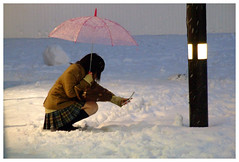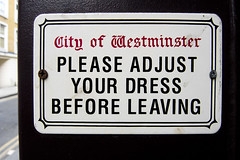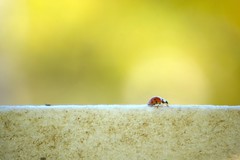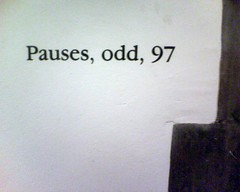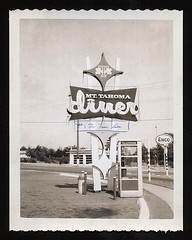[dear facebook] take a page from the flickr playbook[1] and send me my *mail* (and my gifts and my wall sh*t) -- not a *link* to my mail
Martin of (...) fame picked up on my peevishness and poked it with a (very friendly) stick, and we threaded for awhile about user engagement and satisfaction -- in the staccato 140 character bursts that Twitter requires. As a result a somewhat muddled thread emerged.
I promised to clarify my position in a blog post, so here it is. (And for those dear folk who come here for other things, I apologize. And
Here’s a little more of that Twitter thread:
martingruner @suttonhoo: But then u wont go to Facebook.com & look at all the ads. And that, of course, would be just wrong. 'member: its not about you.
suttonhoo @martingruner: lol -- motivation acknowledged -- but it would be interesting to compare engagement numbers AND satisfaction across each UX
martingruner You lost me. Engagement numbers = how many people look at your ads? More ads = less satisfaction?
Martin reasonably assumes that I’m referring to eyeballs on ads when I refer to engagement. And I manage to perpetuate that assumption by lobbing these links over the wall:
suttonhoo engagement e.g. http://tinyurl.com/3c9kdg; for satisfaction something ACSI-like http://tinyurl.com/2wqfo6 ...
The first link refers to a Washington Post piece on the recent revision to the Nielsen/Net Rating (favoring user engagement over page views), and Nielsen’s all about taking measurements that advertisers can use; the second is a link to a run down on the American Consumer Satisfaction Index, which is a way of measuring how happy folks are with their interactions with the folks who sell them stuff. Some look to the ACSI as an important economic indicator.
Martin also put his finger on exactly what I’m complaining about -- Facebook’s gimmick to get folks to login to retrieve their goodies from their friends, like email messages.
Let’s compare user experiences -- this is Facebook’s notification that I’ve received an email through their system:
Emily sent you a message.
To read this message, follow the link below:
http://www.facebook.com/n/?inbox/readmessage.php&t=6524411
And this is Flickr’s:
You've been sent a Flickr Mail from DHVan:
------------------------------------------------------------
:: Nice work
hey i was just doing research for my architecture paper and I stumble on to your pictures from google on your Farnsworth House pictures and they're amazing. But what I wanted to comment on was your "budding bonsai" photo. That picture is just awesome in a serene way. Its very awe inspiring in a way. Thats all I wanted to say. Keep up the good work.
-DHV
------------------------------------------------------------
To reply to this message, click here:
http://www.flickr.com/messages_read.gne?id=72157594572967
To update your email settings, click here:
http://www.flickr.com/account/prefs/notifications/
The Flickr Team
www.flickr.com
The difference from where I’m sitting is tremendous: with Facebook I need to follow the link to see what Emily had to say, and I probably have to login to get there. From a GOMS[2] perspective this is a drag -- click, keystroke, keystroke, keystroke, keystroke, click, click, READ. There’s no way for me to gauge at a glance whether her email is something that needs my immediate attention or can wait until later -- I have to work for it.
With Flickr the pay off is immediate: This is my first encounter with DHVan. If I didn’t have immediate access to his email I probably wouldn’t hassle with retrieving it for a good long while because I have no prior experience about what to expect from Mr. Van. But Flickr sends me his message directly -- so I can immediately bask in his beautiful flattery (and yeah, of course it made my day). If I choose to act on it -- and I did -- I still need to login to Flickr to get the job done, because Flickr mail acts as a shield between me and DH. Either one of us can choose to expose our email to the other if we trust enough, but by default Flickr operates as a go-between.
Both Flickr and Facebook accomplish the same purpose -- getting me to the site, where they have an opportunity to hook me and lure me deeper and engage me with all their good content -- which, yeah, is what matters when you’re measuring these things and trying to turn them into something that will feed you, your family, and your fellow employees. It's just that Flickr does it better.
Back to the Twitter thread:
suttonhoo ...wild ass guesstimate: better user experience at flickr means higher ACSI, offsetting possibly lower (nominally) engagement
martingruner Ok! But why does Flickr have lower engagement? Lower engagement = #ads being seen? 1 of good things w/Flickr=minimal ads.
suttonhoo dunno the actuals and wouldn't measure engagement as ad exposure alone -- just guessing given this: http://tinyurl.com/286pww
I don’t know for a fact that Flickr has lower engagement -- although I know that it has less audience reach than Facebook because Alexa tells me so, and I’ve heard enough about its audience and their goals and objectives to assume that users hang around for a good long while doing their thing. Longer than Flickr users? I dunno. Nominally longer, at best, I would guess.
But what I was trying to get at in 140 characters or less is that as a user of both sites I find the Flickr site more compelling experientially -- the interface is more responsive, I’m better able to connect with the people and the content that I care about than I can over at Facebook -- and that makes me happy. The email design is just another expression of how Flickr is doing a lot of things right.
The Facebook user interface lacks the flow and nimbleness that the Flickr interface possesses -- it simply doesn’t make me happy.[3]
So why does any of this matter? Well certainly this strange non-sequitur makes it all clear:
suttonhoo ...and captology. I think Flickr has the more successful extended experience. tell ya what: I'll blog on it. need more ch.:)
B.J. Fogg’s written a great book[4] and spearheaded the evolution of a whole movement in HCI[5] called Captology, or Computers as Persuasive Technology, which attempts to measure things just like this, and determine whether or not they matter in the way that can be measured.
In Persuasive Technology Fogg recaps a study that the Stanford Persuasive Technology Lab ran on the reciprocity principle. The premise is simple -- as Fogg writes:
One social dynamic that may have potential for persuasive technology is the rule of reciprocity. This unwritten social rule states that after you receive a favor, you must pay it back in some way. Anthropologists report that the reciprocity rule is followed in every human society.
In my laboratory research, my colleagues and I set out to see if the rule of reciprocity could be applied to interactions between humans and computers. Specifically, we set up an experiment to see if people would reciprocate to a computer that had provided a favor for them. [6]
So they did just that -- structuring a study involving an information search on a couple of different computers in which “one group would feel the computer had done a favor for them; the other group would feel the computer had not been helpful.”
The findings were what you might have expected if both participants were human, but surprising when you consider that one of the participants was a computer: “people performed more work for the computer” -- almost twice as much work -- when they felt the computer had done them a favor.
So, long story short: my bias as someone who develops user interfaces and email campaigns has always been to provide something of use, value and general helpfulness. I like to do so because it frankly makes me feel like *I’m* doing something of use, value and general helpfulness -- which is important to me as a human being -- and also because as a customer/user I appreciate these things too.
Because I make a living at this stuff it helps that doing the useful thing also pays off -- in ways that can be measured: Like dollars through the door, time on the site, and return visits.
I.e.: returned favors.
So while Facebook may be more banner ad-centric than Flickr[7] and feel like it needs to do whatever it can to get folks back to the site, my wild ass guess (based on 14 years working in the online space.)(oh good lord I just dated myself, didn’t I?) is that the folks who provide the best user experience will wind up at the end of the day with the greater business success.
They’ll get there in part because they’ll piss me, the user, off less -- and all the better if they make me grateful and glad, ‘cause I’ll love them right back.
That’s a long way around it, but that’s all I was trying to get at this morning. Although I should confess: the email that triggered it was a Facebook gift notification, and when I pulled up the email in gmail just now and it showed all the important component parts -- including a picture of the gift and a message from the giver. I originally saw the email on my handheld device, which doesn’t support the html that gmail does, so the message fell apart and I assumed the worst, based on prior experience with Facebook email messages relating wall posts and inbox notifications, which are missing those vital pieces.
Which opens up a whole other can of worms about the importance of delivering your content in a way that doesn’t degrade across points of access -- mobile being particularly important in the social networking space. But this discussion, frankly, is beginning to tire me out too, so I bid you all a fond goodnight.
[1] actually twittered a malapropism -- “gamebook” and then corrected it in a follow up.
[2] GOMS analysis measures keystrokes, mouse movements, etc. in an effort to quantitatively describe the interaction between computer and user
[3] Could divert here to Don Norman's Emotional Design: Why We Love or Hate Everyday Things, but that would make this even longer. Instead I'll just recommend it. Highly.
[4] BJ Fogg, Persuasive Technology: Using Computers to Change What We Think and Do
[5] HCI = human computer interaction
[6] Fogg, p.108
[7] Flickr is just beginning to generate revenue through a variety of lovely merchandising tie-ins like Zazzle Tees and things, Target photo printing, and Qoop & Moo on-demand printing
